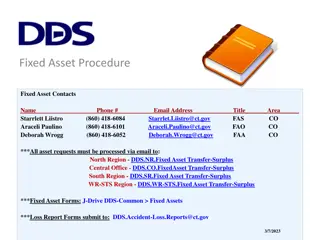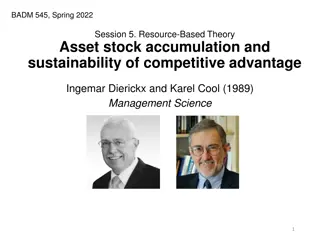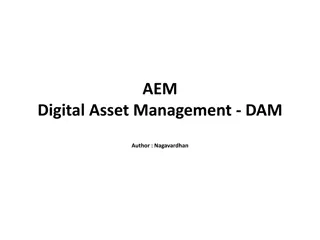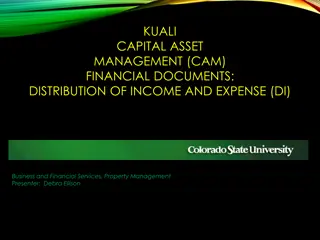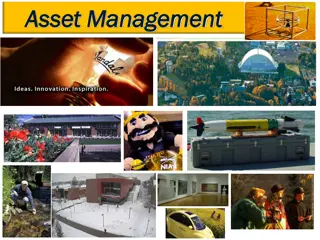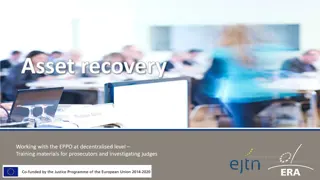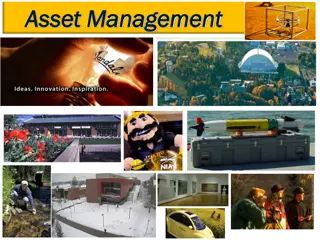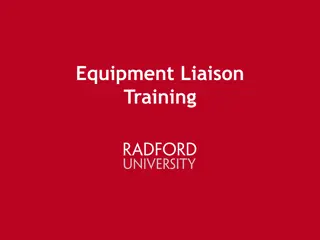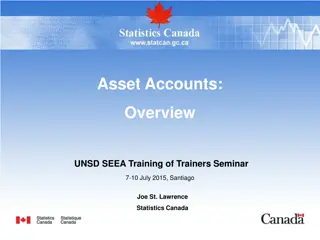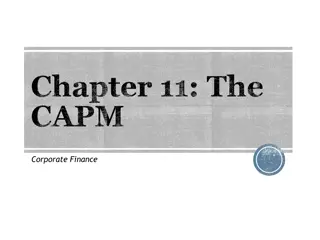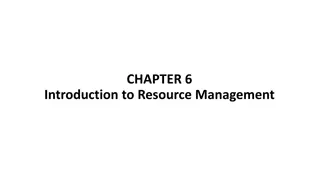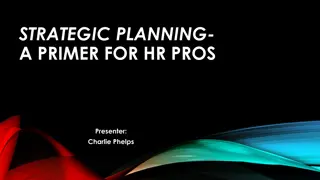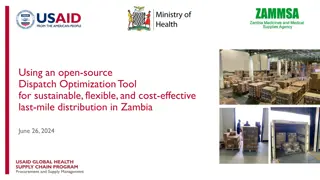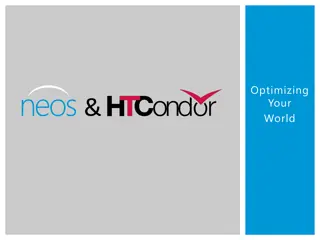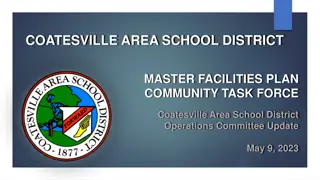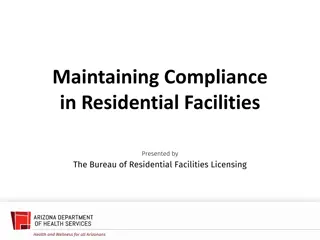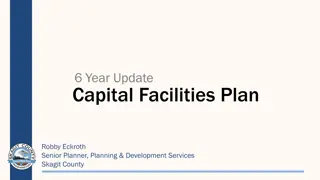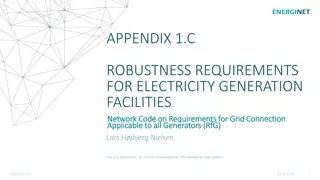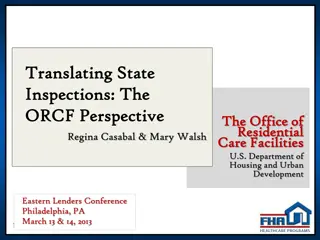Strategic Asset Management for Facilities Optimization
Establish a solid foundation for managing facilities by creating individual asset programs, conducting inventory and data collection, implementing preventive maintenance strategies, estimating effort, and loading data into a centralized CMMS. Asset management is crucial for project managers as it impacts costs, utility, service life, maintenance, productivity, and reliability. Accurate data collection and maintenance is key, outlined in Asset Management Plans (AMP) for each asset class. Personnel involvement and responsibility for data stewardship are highlighted for effective asset management.
Download Presentation

Please find below an Image/Link to download the presentation.
The content on the website is provided AS IS for your information and personal use only. It may not be sold, licensed, or shared on other websites without obtaining consent from the author. Download presentation by click this link. If you encounter any issues during the download, it is possible that the publisher has removed the file from their server.
E N D
Presentation Transcript
Strategic Asset Management Steps to creating a Foundation for Managing our Facilities: 1. Create individual programs for asset classes, consider: Function Tier Uniformat Failure Modes 2. Inventory, collect data, tag assets 3. Describe preventive maintenance programs 4. Estimate PM effort and modify programs to fit the funding 5. Load into CMMS (data in ONE place) 1/28/2021 JG/ SAMP via Sharepoint 1
What is an asset? Anything that has value to the institution people, reputation, endowment, facilities 1/28/2021 JG/ SAMP via Sharepoint 2
So what! How does asset management apply to project managers? Every project touches assets Costs of not managing assets Increased utility cost Decreased service life Increased maintenance cost Decreased staff and faculty productivity Decreased reliability 1/28/2021 JG/ SAMP via Sharepoint 3
Strategic Asset Management Plan Accurate and complete data is required to effectively manage assets. This requires everyone involved with assets to consider themselves a data steward and feel personally responsible for collecting and maintaining reliable data. A written asset management plan (AMP) for each asset class, eg, roofs or backflow preventor, will document details about each asset class and how data will be used to manage the asset class. Appendix XX is a table of asset classes and individuals/organizations responsible for managing that asset class. 1/28/2021 JG/ SAMP via Sharepoint 4
Asset Management Plans (AMP) Asset or System Name SME Program Author Asset or System Name SME Program Author AC Drive Jeff Parsons Electric Motors Access Controls Jeff Parsons Emergency Light Chris Wayman Chris Wayman Air Handler Units Eric Lepore, Liz Kolacki Matt Johnston/Liz Kolacki Emergency Power Supply System (EPSS) (tier 1 for some facilties) Air Stations (Compressors) Mark Fossaceca Kevin Samson Chris Wayman Chris Wayman Backflow Preventer Tom Jordan Gibbs Emergency Egress Stairs Boilers Liz Kolacki Dan Decker Evaporative Coolers (both pad and swamp coolers) Bridges including means restriction Rob Murray Rob Murray Vince Knapp Steve Cobb Carbon Monoxide Detector - not lab gas detection systems Quinn Olsen/Matt Reiter/Elisabete Godden/Shane Dunn Alex Chevallard Chimney/Vent Systems Shane Dunn/Rob Murray Exterior Enclosure (B20) Mark Howe/Cole Tucker/Jim Hatch Fan Coil Units Vince/Scott Burke/ Alyssa Controls Fans Travis Fisher/Alyssa Cooling Tower Vince Knapp Steve Cobb Filter Racks Tom Jordan Cranes and Hoists Marc Marinchak Fire Detection & Alarm System Mark Scholeno Mark Scholeno Dampers / Actuators, including fire/smoke dampers/ lab airflow devices/ VAV boxes Fire Escapes Quinn Olsen and Matt Reiter Liz Kolacki Fire Suppression Systems (sprinklers and halon and kitchen hood) Tom Jordan Tom Jordan Marijane Johnson, Pat Graham, Forrest McCloud Fuel Tanks Dining Equipment Fume Hoods and fans Liz Kolacki/Vince Knapp Domestic Water Heater Travis Fisher Dan Decker Doors and hardware Michael Hingston Alex Chevallard Grease Laden Kitchen Exhaust Systems and fans Drapery and Curtain Nadine Hachmann Asa Schindler Pat Ockenfels Dan Decker 1/28/2021 JG/ SAMP via Sharepoint 5
More Asset Management Plans (AMP) Asset or System Name SME Program Author Asset or System Name Refrigeration Equipment (Process, chambers, and walk-in coolers and ultralows) regardless of owner SME Program Author Greenhouse Shade Curtains Deb Melanson Steve Cobb Heat Exchangers Eric Lepore/ Travis Fisher Eric Lepore/Pat Ockenfels Heat Tracing (Electric & Hydronic) Roof Panel Shane Dunn Shane Dunn Humidifiers both central and point Liz Kolacki Sidewalks Jim Toft Jim Tofte Site Lighting Mark Scholeno Mark Scholeno/ Matt Johnston HVAC related direct expansion refrigerant equipment (includes HVAC Chillers and window AC) Site Stairs Ellen Chase Eric Lepore Steve Cobb Steam Condensate Stations Ice Makers Doug Keefe Alex Chevallard Steam Traps Light Fixtures John Bell Sterilizers and Auto Claves Eric Lepore Marc Marinchak Lighting Fixing Controls John Bell Strainers / Filters Overhead Doors Jason Coolbaugh Rob Murray Dan Decker Sump Pumps Travis Fisher/ Vince Knapp Parking Garage Rob Murray Swimming Pools Roy Baker Asa Schindler Pavement Jim Toft Jim Tofte Unit Heaters Portable Fire Extinguishers Alex Chevallard Valves Mark Howe/Cole Tucker? Pressure Vessels Vince Knapp/Travis Fisher Vertical Conveyance Systems Kevin Samson Kevin Samson Quin Olsen/Matt Reiter/Shane Dunn/ Elisabete Primary & Secondary Elec. Switchgear Erich Reichard, Jeff LaPar Erich Reichard/ Jeff LaPar Vertical Enclosures Pumps Travis Fisher/ Tom Jordan Matt Kozlowski/Vince Knapp/Travis Fisher Waste Water Discharge Systems Quality Water Systems (and softeners) Travis Fisher Matt Johnston Bulk Petroleum Storage 1/28/2021 JG/ SAMP via Sharepoint 6
Strategic Asset Management Plan Aspirational Aspirational Asset Audit & Update Process (work in progress): Design teams will identify asset types included in the design documents and populate applicable characteristic information. The contractor will then further update the list as they procure or install assets. They will also update asset types if they change in the course of construction. The construction team will attach operation and maintenance manuals to each individual asset. The commissioning agent will audit the list and submit it to Facilities Management. Facilities Management will provide labels for installation by the contractor. The commissioning agent will audit the label installation. Any volunteers to help with this? 1/28/2021 JG/ SAMP via Sharepoint 7




